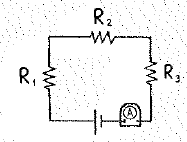
The circuit below contains resistors

Rank the following combinations of resistances in terms of the current measured by the ammeter, from highest to lowest.
(A)
(B)
(C)
Ranking of the different combinations of the resistances in terms of current from the ammeter in the circuit.
Answer to Problem 17A
The ranking of combination of resistances A, B, and C from highest to lowest is C, A, B.
Explanation of Solution
Given info:
(A)
(B)
(C)
Formula Used:
The expression to calculate the total resistance of circuit for combination (A) is,
The expression to calculate the total resistance of circuit for combination (B) is,
The expression to calculate the total resistance of circuit for combination (C) is,
Calculation:
Substitute the values in the above expression.
Substitute the values in the above expression.
Substitute the values in the above expression.
The total circuit resistance for the combination (C) is highest, total circuit resistance for the combination (B) is least and total circuit resistance for the combination (A) is between highest and lowest circuit current.
Conclusion:
Thus, the ranking of combination of resistances A, B,C from highest to lowest is C, A, B.
Chapter 35 Solutions
Conceptual Physics: The High School Physics Program
Additional Science Textbook Solutions
Introductory Chemistry (6th Edition)
Microbiology: An Introduction
Human Biology: Concepts and Current Issues (8th Edition)
Brock Biology of Microorganisms (15th Edition)
Cosmic Perspective Fundamentals
Applications and Investigations in Earth Science (9th Edition)
- Which of these properties of a sound wave is associated with the pitch of the sound that we hear? amplitudefrequency intensity levelintensityarrow_forwardA wave travels upward in a medium (vertical wave velocity). What is the direction of particle oscillation for the following? (a) a longitudinal wave parallel to the direction of propagationperpendicular to the direction of propagationarrow_forwardThe faster a molecule is moving in the upper atmosphere, the more likely it is to escape Earth's gravity. Given this fact, and your knowledge of rms speed, which of the following molecules can escape most easily from Earth's atmosphere if they are all at the same temperature?arrow_forward
- The temperature in one part of a flame is 2,100 K. What is the rms velocity of the carbon dioxide molecules at this temperature? Give your answer as the number of meters per second. mass of 1 mole of CO2 = 44.0 grams 1 mole contains 6.02 x 1023 molecules the Boltzmann constant k = 1.38 x 10-23 J/Karrow_forwardThe specific heat of a certain substance is 375 J/(kg°C). How much heat energy would you have to add to increase the temperature of 22 kg of this substance from 33°C up to 44°C in a number of Joules?arrow_forward3.9 moles of an ideal gas are sealed in a container with volume 0.22 m3, at a pressure of 146,000 N/m2. What is the temperature of the gas in degrees Celsius?arrow_forward
- when a cannon is launched at a 65 degree angle, will it have the same horizontal velocity as when it is launched from a 25 degree angle as long as the initial speed is the same?arrow_forwardPlease solve the problem step by step and provide explanations along each step stating what's being done. Thank you!!arrow_forwardNo chatgpt pls will upvotearrow_forward
- Plz both no chatgpt Will.upvotearrow_forwardPlease solve the problem step by step with explanations along each step explaining what's been done.Thank you!!arrow_forwardFigure 8.14 shows a cube at rest and a small object heading toward it. (a) Describe the directions (angle 1) at which the small object can emerge after colliding elastically with the cube. How does 1 depend on b, the so-called impact parameter? Ignore any effects that might be due to rotation after the collision, and assume that the cube is much more massive than the small object. (b) Answer the same questions if the small object instead collides with a massive sphere.arrow_forward
 College PhysicsPhysicsISBN:9781305952300Author:Raymond A. Serway, Chris VuillePublisher:Cengage Learning
College PhysicsPhysicsISBN:9781305952300Author:Raymond A. Serway, Chris VuillePublisher:Cengage Learning University Physics (14th Edition)PhysicsISBN:9780133969290Author:Hugh D. Young, Roger A. FreedmanPublisher:PEARSON
University Physics (14th Edition)PhysicsISBN:9780133969290Author:Hugh D. Young, Roger A. FreedmanPublisher:PEARSON Introduction To Quantum MechanicsPhysicsISBN:9781107189638Author:Griffiths, David J., Schroeter, Darrell F.Publisher:Cambridge University Press
Introduction To Quantum MechanicsPhysicsISBN:9781107189638Author:Griffiths, David J., Schroeter, Darrell F.Publisher:Cambridge University Press Physics for Scientists and EngineersPhysicsISBN:9781337553278Author:Raymond A. Serway, John W. JewettPublisher:Cengage Learning
Physics for Scientists and EngineersPhysicsISBN:9781337553278Author:Raymond A. Serway, John W. JewettPublisher:Cengage Learning Lecture- Tutorials for Introductory AstronomyPhysicsISBN:9780321820464Author:Edward E. Prather, Tim P. Slater, Jeff P. Adams, Gina BrissendenPublisher:Addison-Wesley
Lecture- Tutorials for Introductory AstronomyPhysicsISBN:9780321820464Author:Edward E. Prather, Tim P. Slater, Jeff P. Adams, Gina BrissendenPublisher:Addison-Wesley College Physics: A Strategic Approach (4th Editio...PhysicsISBN:9780134609034Author:Randall D. Knight (Professor Emeritus), Brian Jones, Stuart FieldPublisher:PEARSON
College Physics: A Strategic Approach (4th Editio...PhysicsISBN:9780134609034Author:Randall D. Knight (Professor Emeritus), Brian Jones, Stuart FieldPublisher:PEARSON





